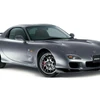F1 unveils mock-up of new style cars expected for 2022

- F1 unveils first look at new era
- Major aerodynamic changes expected to improve racing
- Delayed rules set to transform the look of F1
F1 cars will have a much changed appearance from next season onwards, as new regulations are introduced with the hope of spicing up the racing action.
An interpretation of how the new era will look was shown off for the first time at Silverstone on Thursday, with the rules delayed from this year to 2022 thanks to the Covid-19 pandemic. The main focus is on the aerodynamics of the car; for decades the front and rear wings have created a ‘dirty air’ effect, which has compromised the ability of cars to follow each other closely through the corners.
For an F1 car to operate at its peak performance levels, the airflow over the wings - which produce massive amounts of downforce to keep the cars stuck to the track and therefore lap quicker - needs to be as clean as possible. That ability is massively compromised when following another car, thus slowing it down and normally ending any chance of making an overtaking move.
The new regulations aim to simplify the airflow, and remove vortexes that cause major disruption. That means the front wing end plates are much simpler, and the front wing shape is changed too. The intention here is for the wing to be less sensitive when following another car.
For the first time, F1 cars will have small winglets directly above the tyres (which are also massively changed for 2022, more on that below), again to clean up the airflow.
The rear wings have a drastic change; out go the boxy constructions that have dominated the rear of F1 cars since the 1970s, and in their place comes a heavily sculpted design that will lift air above following cars rather than throw it directly at them.
F1 cars will also take a step back in time next year, when underfloor downforce beneath the car is given priority over the wings, for the first time since the 1980s. The theory, known as ground-effect, is that the downforce created underneath the car will be powerful but affected far less when following another car compared to conventional aerodynamics, but will also create much lower levels of air disruption to cars behind.
The tyres will also undergo the biggest change for many years too. F1 has run on 13 inch wheels for several decades, but these will be switched for more contemporary 18 inch wheels with lower profile tyres, while wheel covers will return too, further simplifying the airflow.
Bodywork around the driver and the sides of the cars will be cleaned up as well. Barge board structures were re-legalised in recent seasons, but their increasing complexity has added to the levels of dirty air created, and thus these will be banned again.
Nose cones will also be lowered and connected directly to the front wing. F1 cars have had raised noses since the early 1990s, indeed the last car to feature a low nose was the ungainly 1996 Ferrari, which proved so unsuccessful that the nose was raised midway through the season. Again, this change helps to clean up the aerodynamics.
While the car on display matches computer generated imagery released by F1’s governing body the FIA in recent years, its likely that the cars on next year’s grid will be different to what’s been displayed this week.
Each team will still have to produce their own cars, and each will have their own interpretations of the regulations. So there’s every chance next year’s grid will be rather more varied in appearance than recent years; stable regulations lead to hugely refined designs, with all cars looking more and more alike one another as understanding and recognition of the best theories gets picked up by each operation.
Simulations suggest that with the changes, following cars will retain 86% of their downforce compared to around 55% on the current designs. Whether that translates into better racing will be made clear in just a few months time.
Richard Randle is a motorsport PR professional working with the UK’s top racing circuits and the UK’s premier single-seater category, the BRDC British F3 Championship.


